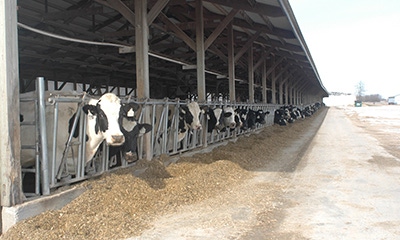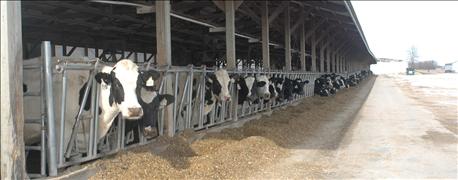
Dairy product prices have been declining which means lower milk prices for the first quarter of 2016, according to Bob Cropp, University of Wisconsin Extension dairy economist.

Bob Cropp predicts says Class III futures could well be in the $15's by the third quarter.
On the Chicago Mercantile Exchange, butter averaged $2.8779 per pound for November, started December at $2.90, but fell to $2.06 by the last week of 2015. The 40-pound cheddar cheese price was $1.71 per pound back on Nov. 11 and averaged $1.6176 for the month. The 40-pound block price started December at $1.56 per pound and fell to $1.44 by the end of December. The cheddar barrel price was $1.65 per pound in early November and averaged $1.53 for the month. The barrel price was $1.515 per pound the beginning of December and dropped to $1.45 per pound by Dec. 29.
"Hopefully the cheese prices have bottomed and perhaps will show a little strength over the next month or two, but butter prices are likely to decline some more and nonfat dry milk and dry whey prices may hold or show some strength," Cropp says. With lower dairy product prices, the December Class III price was $14.50 compared to $15.31 in November.
"Unless prices do rally, which is not likely over the next couple of months, we could see the Class III price in the low $13’s first quarter of 2016," he adds.
What is driving lower dairy product prices and milk prices?
"While the relative increase in milk production in 2015 through November is just 1.2% higher than 2014 that is still a lot of milk considering 2014 saw an increase of 2.3%," Cropp says. Milk production for the year was about 1.1% higher than 2014.
USDA’s milk production report indicates the increase in milk per cow remained well below trend at just 0.2%, Cropp notes. The relative regional change in milk production continued with declining or slow increases in the West and good increases in the Northeast and Midwest. Eight of the 23 reporting states showed a decrease in milk production for last year with all accept one, Virginia being in the West. California continues to experience the biggest relative decrease, 4.4% and also in absolute terms, 149 million pounds. While cow numbers were down 4,000 head, milk per cow being 4.2% lower was the main reason for the decrease. The biggest relative increase in milk production was South Dakota at 13.1% followed by Wisconsin at 4.3%.
With California’s milk production lower, and being the number one butter producer, U.S. butter production is actually 1.7% lower than a year ago. But, October butter exports were 57% lower than a year ago and 69% lower year to date. So butter stocks were actually 21% higher than a year ago, according to Cropp.
~~~PAGE_BREAK_HERE~~~
Lower margins
While feed costs this winter will be a little lower than last year low milk prices at least for the first half of the year will squeeze returns over feed costs, Cropp says. As a result, cow slaughter will be higher than a year ago and increases in milk per cow reduced.
"Milk production may show little or no increase over a year ago for the first half of next year," he explains. "Sales of butter and cheese should continue to show growth. With milk prices also depressed in major exporting countries world milk production is likely to increase less than in 2015, and as a result slowly reduce the world buildup of stocks. So world prices ought to improve as we move through the year."
Recent trading on the Global Dairy Trade has already shown some strengthening of prices. With lower U.S. prices and higher world prices, Cropp predicts U.S. dairy exports should improve by the second half of the year. With slower growth in U.S. milk production and improved exports milk prices will show recovery.
"The Class III price could well be in the $15’s by the third quarter and the $16’s in the fourth quarter with peaking in the low $17’s a possibility," he concludes. "Current Class III futures have weakened a lot with Class III below $14 for January and February. Futures don’t reach the $15’s until June and $16’s until August and it peaks around $16.30 in October."
About the Author(s)
You May Also Like






